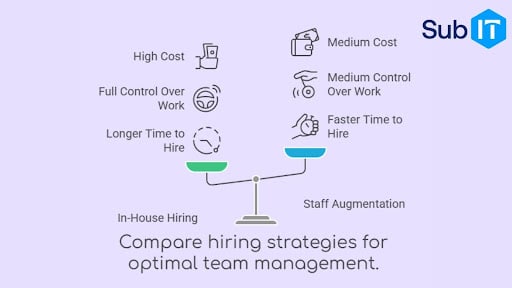
When your internal team is stretched thin or missing key technical skills, projects stall, and growth slows. That’s where IT staff augmentation can quietly step in and make a big difference. It gives you instant access to skilled professionals who can plug into your workflow, and free up your team to focus on what they do best.
According to Business Research Insights, the global IT staff augmentation market hit $299.3 billion in 2023 and is expected to nearly triple by 2032. With growth like that, it’s clear this model is helping businesses solve real-world staffing challenges
At SubIT, we offer IT solutions that can stand against constant market changes, giving businesses reliable talent that feels like part of the team, no matter where they are working from.
Key Takeaways
- IT staff augmentation lets you quickly add skilled developers without long-term hiring.
- It’s a flexible, cost-effective way to fill gaps and speed up project delivery.
- Compared to other hiring models, it gives you more control and faster results.
- Choosing the right partner makes a big difference in communication, security, and team fit.
What Is IT Staff Augmentation?
IT staff augmentation is a way to quickly bring skilled developers or tech professionals into your team, without the long process of hiring someone full-time. Instead of going through months of recruiting, you “borrow” professionals from a staffing partner and plug them into your project right when you need them.
You still manage the work. You keep control of the project. The only difference is that the people helping you might be working for another company, or even in another country. They’re part of your team while the project lasts, and when it’s done, you both move on.
How IT Staff Augmentation Works
Bringing augmented staff into your team allows you to fill in gaps without turning your whole hiring process upside down.
And timing matters: according to a 2024 LinkedIn report, tech roles take an average of 5 to 6 months to fill, much longer than the 42-day average for non-tech jobs. Augmentation cuts through that, letting you bring someone on board in a matter of days, not months.
Step-by-Step Breakdown
- You spot a need.
Maybe your current team is maxed out. Maybe you need a backend developer who knows Python, and fast. Either way, you realize you’re missing something critical to get the job done. - You reach out to a staff augmentation partner.
These are companies that focus on connecting businesses with skilled IT professionals. They already have vetted developers, engineers, and designers, ready to go. - They send over matches.
You get a shortlist of candidates who fit your needs. You can interview them just like you would with a full-time hire. - You make the call.
You pick the people who feel like a good fit by assessing their skills, communication style, and time zone. - They join your team.
The developers integrate into your workflow. They get assigned tasks in your sprint. They use your tools. It’s like they’ve always been there. - You manage the work.
You’re still in control. These folks aren’t working for the staffing agency, they’re working with you. You decide the priorities and how the job gets done. - When the job’s done, they roll off.
Once the project ends, so does the engagement. No layoffs, no long-term overhead.
Different Ways to Augment
Staff augmentation isn’t one-size-fits-all. There are different models based on what you need:
- Short-term augmentation: Ideal for quick fixes or extra hands during crunch time.
- Long-term augmentation: Great for ongoing projects where you need consistent support over several months.
- Nearshore or offshore models: Some teams bring on talent from nearby countries for an easier time zone overlap. Others go global to tap into wider expertise and better rates.
Each setup has trade-offs. Nearshore developers might cost more but offer smoother communication. Offshore teams could be more affordable but require better coordination across time zones. The right choice depends on your workflow and how closely you need to collaborate.
Benefits of IT Staff Augmentation
You’ve got a project to deliver. The clock’s ticking. Your team’s already stretched. Bringing in more people sounds great, until you remember how long hiring takes. That’s where IT staff augmentation makes a real difference.
Cost-Efficient Without Cutting Corners
Hiring full-time developers takes time, effort, and budget. With staff augmentation, you skip most of that. You pay only for the time and talent you need.
- No long-term contracts
- No employer taxes or benefits
- No overhead from idle staff between projects
Access to Niche Talent
Augmentation connects you with specialists who can jump in and contribute right away.
This is especially useful when:
- You’re building something outside your team’s usual stack
- You need niche skills temporarily
- You want top-tier talent without full-time commitments
Speed and Flexibility
Traditional hiring can take weeks or months. Staff augmentation? Days.
- You scale up your team as the project grows
- You scale down when the workload eases
- You adjust on the fly, no red tape, no slow approvals
For fast-moving startups or project-based teams, this kind of flexibility is gold.
Control Stays With You
Unlike outsourcing, you don’t hand off the whole project.
- You assign the tasks
- You manage timelines
- You keep code quality and team culture intact
Fresh Eyes and New Energy
Sometimes, just adding a new person to the mix can spark progress. Augmented staff bring experience from other companies and projects. They may offer new ways of thinking, smoother processes, or tools your team hasn’t tried yet.
7 Signs You Should Choose IT Staff Augmentation?
Staff augmentation isn’t the answer to every staffing problem, but it’s a smart solution in a lot of situations.
1. You’re Facing a Tight Deadline
A product launch is coming up, but there’s too much work and not enough hands. You don’t have time to hire, onboard, and train. Augmented staff can join quickly and start contributing within days, not weeks.
2. Your Team Lacks a Specific Skill
Maybe you need a DevOps engineer for infrastructure work or a UX designer to polish the front end. If the skill gap is temporary or too specialized for a full-time hire, augmentation fills the role without long-term commitment.
3. Your In-House Team Is At Capacity
Even the best teams hit their limit. Instead of overloading your developers or delaying the project augmentation, let you expand your team on demand without burning anyone out.
4. You’re Building a New Product or MVP
Startups and innovation teams often need to move fast and prove a concept. You might not have all the right skills on staff yet. Augmentation lets you assemble a lean, experienced team that can build, test, and ship quickly.
5. You Want to Test Before You Hire
Not sure if you need someone long-term? Use staff augmentation as a “try before you buy.” If the person fits your culture and you have the budget, you can offer a full-time role later. If not, no strings attached.
6. You’re Scaling Up for a Big Contract
Landing a new client is exciting, but it also means more work. Augmentation helps you take on bigger projects without stretching your core team too thin or rushing into permanent hires.
7. You Need Extra Support During a Crunch Period
Seasonal surges, year-end deadlines, or back-to-back releases can overwhelm even well-staffed teams. Temporary help keeps things on track without long-term costs.
IT Staff Augmentation vs Other Hiring Models

When you’re trying to grow your tech team, you’ve got a few options on the table: hire in-house, outsource the whole project, use freelancers, or go with staff augmentation.
Staff Augmentation vs In-House Hiring
In-house hiring gives you full-time employees who are part of your team for the long haul. That’s great if you’ve got steady workloads and the budget to support them. But it takes time to find the right people, and even longer to onboard them.
Staff augmentation, on the other hand, is faster and more flexible. You still manage the work like you would with your own team, but you don’t have to commit to long-term costs.
Staff Augmentation vs Outsourcing
Outsourcing means handing off a full project to an external team. They plan it, build it, and test it on their timeline and terms. You lose some control, but it can work well if you don’t have the time or resources to manage the process yourself.
With staff augmentation, you’re still in charge. The developers work under your lead, use your tools, and follow your roadmap.
Staff Augmentation vs Freelancers
Freelancers are typically solo professionals hired for short-term work. They’re affordable, easy to find, and great for simple or one-off tasks. But reliability can be hit-or-miss, and they may not always be available when you need them again.
Augmented staff usually come from agencies or talent networks, so there’s more vetting, support, and accountability. They’re ready to integrate with your workflow like any other team member.
Challenges of Staff Augmentation (And How to Overcome Them)
IT staff augmentation is powerful, but it’s not perfect. Like any team model, it comes with its own set of challenges.
Communication Gaps
When part of your team is remote, things can get lost in translation. Time zones, language differences, or just not being in the same Slack channels can cause delays or confusion.
How to fix it:
- Use one clear communication tool for everyone (Slack, Microsoft Teams, etc.)
- Set overlapping work hours when possible
- Define expectations early: who reports to whom, how updates are shared, and what “done” looks like
Team Integration
Augmented staff aren’t just extra hands, they’re part of the team, even if it’s temporary. If they feel like outsiders, collaboration can suffer.
How to fix it:
- Include them in standups, retros, and team chats
- Give them access to the same tools and docs as in-house devs
- Treat them like teammates, not temps
Knowledge Transfer
The augmented developer knows how a feature works, but what happens when they leave? Without good documentation and handoff, knowledge can walk out the door with them.
How to fix it:
- Encourage documentation as the work progresses, not just at the end
- Have them walk through their code or solutions with an in-house dev
- Keep important context in shared spaces (like Notion, Confluence, or GitHub wikis)
Security and Compliance
Sharing sensitive data or code with external staff raises fair concerns. Especially in industries with strict compliance requirements.
How to fix it:
- Use NDAs and access control from day one
- Set up secure VPNs and version control permissions
- Limit access to only what they need, nothing more
Need the Right People, Right Now?
When your team’s ready to grow but you’re not looking to hire full-time, staff augmentation can fill that gap fast, with the skills, flexibility, and control you need to keep projects moving.
SubIT makes that process simple. If you’re ready to add real talent without the long ramp-up, reach out through our contact page. We’ll help you find the right fit for your team, right when you need it.


